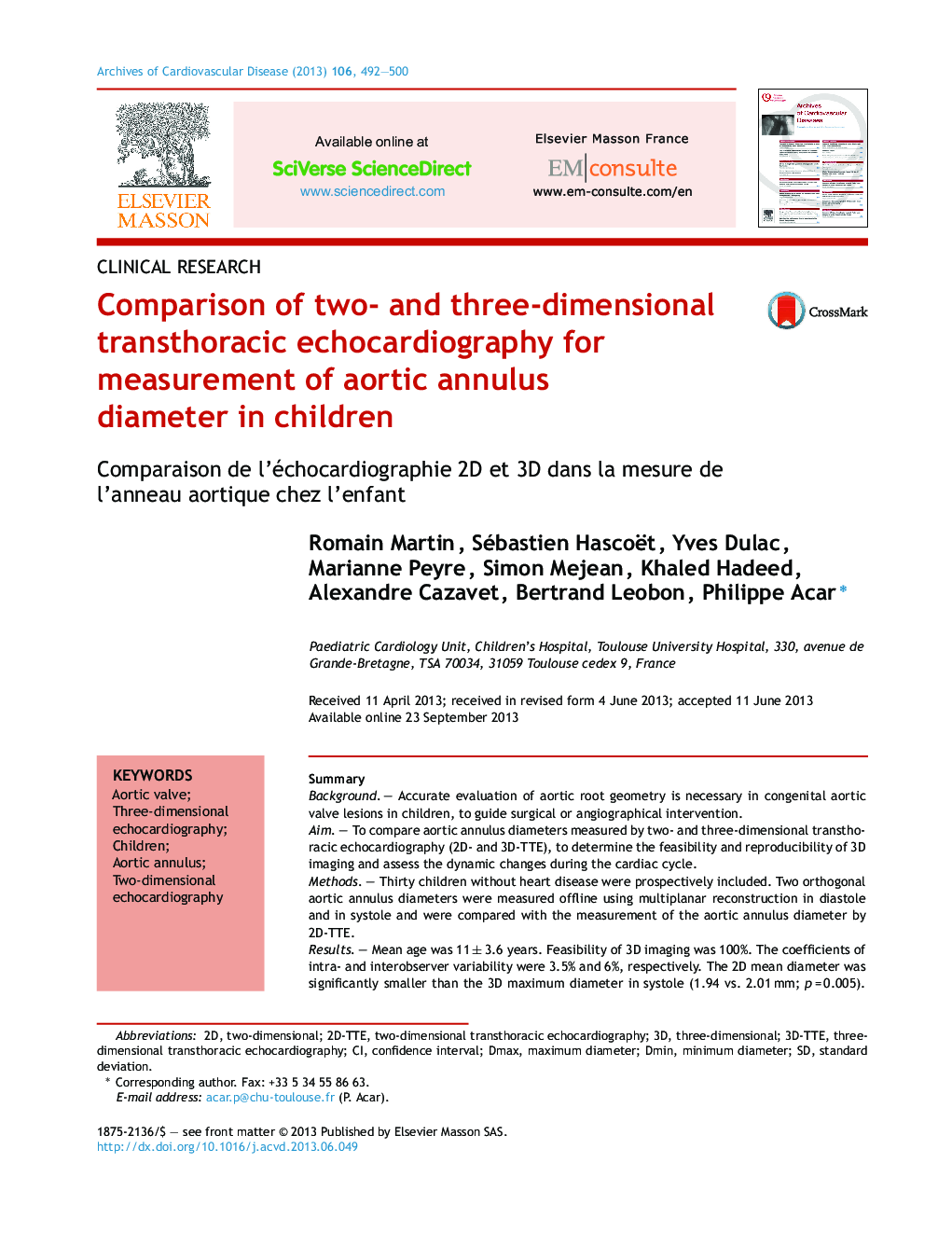| کد مقاله | کد نشریه | سال انتشار | مقاله انگلیسی | نسخه تمام متن |
|---|---|---|---|---|
| 2888729 | 1574361 | 2013 | 9 صفحه PDF | دانلود رایگان |

SummaryBackgroundAccurate evaluation of aortic root geometry is necessary in congenital aortic valve lesions in children, to guide surgical or angiographical intervention.AimTo compare aortic annulus diameters measured by two- and three-dimensional transthoracic echocardiography (2D- and 3D-TTE), to determine the feasibility and reproducibility of 3D imaging and assess the dynamic changes during the cardiac cycle.MethodsThirty children without heart disease were prospectively included. Two orthogonal aortic annulus diameters were measured offline using multiplanar reconstruction in diastole and in systole and were compared with the measurement of the aortic annulus diameter by 2D-TTE.ResultsMean age was 11 ± 3.6 years. Feasibility of 3D imaging was 100%. The coefficients of intra- and interobserver variability were 3.5% and 6%, respectively. The 2D mean diameter was significantly smaller than the 3D maximum diameter in systole (1.94 vs. 2.01 mm; p = 0.005). 2D and 3D measurements were well correlated (p < 0.0001). The maximum and minimum diameters in 3D were significantly different both in systole and in diastole (p < 0.001) underlining an aortic annulus eccentricity. The mean aortic annulus diameters were not significantly different between systole and diastole, with important individual variability during the cardiac cycle.ConclusionThis study demonstrated the feasibility and reproducibility of 3D-TTE for the assessment of the aortic annulus diameter in a normal paediatric population. Because of an underestimation of the maximum diameter by 2D-TTE and the asymmetry of the aortic annulus, 3D measurements could be important before percutaneous aortic valvuloplasty or surgical replacement.
RésuméContexteL’évaluation de la géométrie de la racine aortique est indispensable avant toute chirurgie ou cathétérisme interventionnel de la valve aortique.ObjectifLe but de l’étude a été de comparer le diamètre aortique par échocardiographie transthoracique, de déterminer la faisabilité and la reproductibilité de l’imagerie 3D et d’analyser la variation au cours du cycle cardiaque.MéthodesTrente enfants sans cardiopathie ont été étudiés prospectivement. L’anneau aortique a été mesuré dans deux plans orthogonaux en systole et diastole en utilisant un logiciel multiplan 3D et comparé au diamètre 2D.RésultatsL’âge médian était de 11 ± 3,6 ans. La faisabilité de l’écho 3D était de 100%. Le coefficient de variabilité intra- et interobservateur était de 3,5% et 6%. Le diamètre moyen 2D était inférieur au diamètre 3D en systole (1,94 vs 2,01 mm; p = 0,005). Les mesures 2D et 3D étaient bien corrélées (p < 0,0001). Les diamètres maximal et minimal 3D de l’anneau aortique étaient différents de façon significative en systole et en diastole soulignant l’excentricité de l’anneau aortique (p < 0,001). Le diamètre moyen de l’anneau aortique n’était pas différent entre la systole et la diastole avec une importante variabilité individuelle au cours du cycle cardiaque.ConclusionCette étude montre la faisabilité et la reproductibilité de l’écho 3D dans la mesure de l’anneau aortique chez l’enfant. Dans la mesure où l’écho 2D sous-estime le diamètre de l’anneau aortique à cause de son asymétrie, l’écho 3D peut être un examen important avant un geste percutanée ou chirurgicale de la valve aortique.
Journal: Archives of Cardiovascular Diseases - Volume 106, Issue 10, October 2013, Pages 492–500